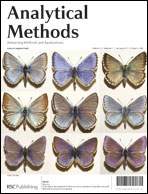Rapid prototyping of polymeric electrophoresis microchips with integrated copper electrodes for contactless conductivity detection
Abstract
A simple and easy approach to produce polymeric microchips with integrated copper electrodes for capacitively coupled contactless conductivity detection (C4D) is described. Copper electrodes were fabricated using a printed circuit board (PCB) as an inexpensive thin-layer of metal. The


 Please wait while we load your content...
Please wait while we load your content...